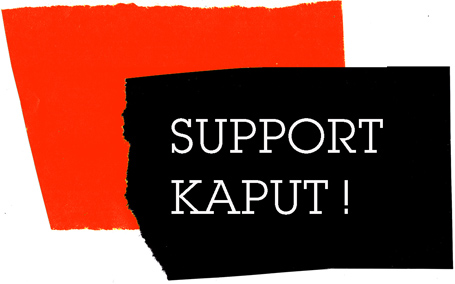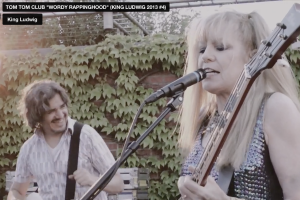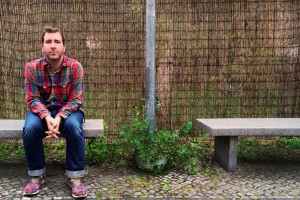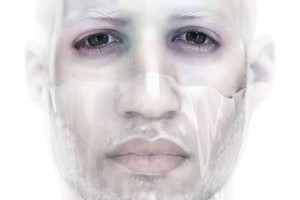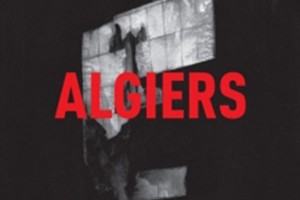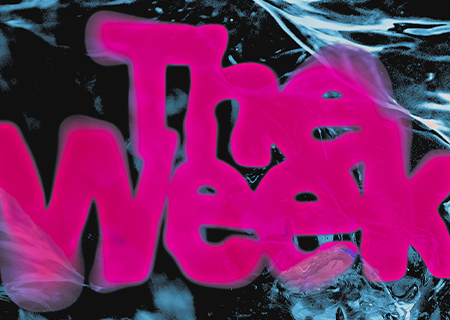Kim Gordon: “I’ve always felt more like an artist and kind of an outsider in the music world”

Exhibition view “Kim Gordon for Design Office – Is this on the approved playlist” © Courtesy the artist, JUBG Cologne & 303 Gallery New York 2022 © Photos Mareike Tocha Cologne 2022
Kim Gordon could be called the grand dame of American indie rock. With Sonic Youth, she played a major role in shaping the genre and, beyond that, the structures of the independent music industry, so much so that the band’s 1991 “The Year Punk Broke” European tour is retrospectively classified as the moment when the indie scene finally lost its innocence in the slipstream of Nirvana’s success and the gold rush that followed.
But one does not do justice to Kim Gordon if one reduces her to the membership of Sonic Youth. On the one hand, there is the impressive catalog of other music projects such as Harry Crews, Free Kitten, Body/Head or Mirror/Dash, on the other hand, her second career as a visual artist (which, strictly speaking, was once her first career).
“Kim Gordon for Design Office – Is this on the approved playlist” is on view at the Cologne gallery JUBG.
Thomas Venker and Kim Gordon spoke with via Zoom.

“Kim Gordon for Design Office – Is this on the approved playlist” © Courtesy the artist, JUBG Cologne & 303 Gallery New York 2022 © Photos Mareike Tocha Cologne 2022
Kim, what was the last exhibition that impressed you and why?
I was recently in New York at Christies, because that non-profit LAXART that I am on the board was having an auction to raise money to buy a building. So we walked around and looked at all the works –contemporary art, impressionism, masterpieces, all kind of stuff. I never knew you could just walk in and look at all he works – a little bit like in a museum but with price tags. It was interesting how distracting that became, suddenly being interested in how much the Degas was in compare to some of the contemporary art: „Oh, this is actually so much cheaper than I thought…“
Just think how weird it would be if museums did that. People would probably think one artwork is more important than another just based on how much it is.
That’s how a lot of people think for sure. I walked around Art Cologne and a gallery like Johann König for example is putting the prices on while everybody else does not. It is kind of weird as one immediately starts ckecking this out. Not that we don’t know this is a market, but still it is weird to have the numbers in your face.
Yeah, right.
There has been one work of you show at the Art Cologne. In addition I saw yesterday a post of you on Instagram with artist Jessica J. Hutchins and her daughter at your place in Los Angeles – in the background there were some more recent works of you visible. Is that what we can expect for your exhibition at JUBG?
One of those paintings – and another one, a much larger one. But there is also an audio component.
The large painting I kind of worked on, on and off. The pink ones are pretty recent. It is challenging to make pink paintings. I was trying to do these paintings that are in between figurative and abstract – or painting over figurative paintings to make them abstract.
Those are not only pink paintings, they are also white paintings of course as it is the relationship between the colours that create the tension in the works.
That’s true.

Exhibition view “Kim Gordon for Design Office – Is this on the approved playlist” © Courtesy the artist, JUBG Cologne & 303 Gallery New York 2022 © Photos Mareike Tocha Cologne 2022
If anyone has paid even a little attention to the history of Sonic Youth, they’ll know about your background as a visual artist. After studying art at Otis College for Art and Design, you began writing exhibition reviews for the American art magazine Artforum in the early 1980s and had your first solo show at New York’s White Columns gallery in 1981. So you were perfectly positioned for a career in the art world – but then you met Lee Ranaldo and Thurston Moore and and you formed Sonic Youth. Did that immediately feel like an either/or situation?
In the late 80s and early 90s I guess I wasn’t really making any artworks. (…) In the early 80s I started this design office in New York, making interventions in peoples apartments and doing something that was like psychological interior design – introducing an object in the place that had something to do with them. I only ended up doing a few of them. And I also kept doing some writing for Artforum and other small publications. But yeah, the band did kind of take over from there.
But then in the early 1990s I started painting again. I has been more the early 2000s when I felt I really own it to my self to get back into exploring a career in art again. But it always felt to me like an artist playing music. I was interested in this than rather make comments on the popular culture from outside. Being in a band was actually being in popular culture – even though we weren’t that popular, we were subculture.
Well, you definitely had a significant position.
I mean, it grew a bit. It was about writing lyrics that have to do with popular culture for me, trying to work within it in oppose to being cynical from the outside.
I’ve always felt more like an artist and kind of an outsider in the music world. Because I had no training as a musician. And part of my vocabulary playing music was actually trying not to learn to play better.
What only works for a certain time and then…
Trying to be a bad musician or a non-musician. The only thing that feels natural to me in music is doing improv basically. I first got into music through that music and that felt really free and natural to me.
These paintings I am doing are kind of like that. I also do other things in the art crafts that are maybe more conceptional but these paintings are about … not being a bad painter but trying not to paint well. Nothing new about that.

“Kim Gordon for Design Office – Is this on the approved playlist” © Courtesy the artist, JUBG Cologne & 303 Gallery New York 2022 © Photos Mareike Tocha Cologne 2022
From a bird’s eye view, it seemed like you completely stopped making art at that time, if only because Sonic Youth very quickly left no time for it. Was that easy for you? Looking back, can you pinpoint the point where the longing to practice as a visual artist came up again?
It felt that I owe it to myself. I always wanted to be an artist from the time that I was little – which is such a cliché. But it is true. I went to a lab school in LA that was all about learning by doing. So whatever we studied we would make things and play/act it out. I feel that influenced me a lot. Music, art, it is just another form of expression, another outlet. I guess early on I worked at a gallery, 1981, and I kind of freaked out about the art world. So music became a little bit of an escape for me.
In 2012 I saw an exhibition of yours (together with Monika Baer and Nick Mauss) at the then still existing Berlin gallery Mathew, run by the two Dial label owners Peter M. Kersten and David Lieske. Like JUBG, it’s a place where the art and music scenes meet. What does that mean for you as a visual artist?
I did not really think about it like that at the time. I met David in New York and he basically just asked me if I wanna do the show.
I mostly avoid those situations. I have been asked to be in many shows with other musicians who make art and I always pretty much say ‘no’.
And now you exhibit in exactly such a gallery…
But it goes back and forth: it is not such musicians that make art, it is also artists that make music. The context of it feels more natural to me. And also in LA I feel I need to keep everything separate.
Are there different practices of preparation for exhibitions when you know that the visitors inside will come rather from the music world? For example, you mentioned that this time you’re also producing a sound piece for the exhibition, you don’t always do that.
It is a kind of audio piece, there is no music or sound other than my voice. I recently had an installation at Reena Spauling’s Gallery in LA called „The Pitch“ that also had a spoken word / written text part. Anyway, I thought it is a gallery that has musicians, so I should do some sound part.
Also the logo got a music connection, it is a homage to the CBGBs logo.
Ha, that’s funny. Which is now a designer store.
Well, right.
It is not a new phenomenon that musicians are also active as artists and artists often produce music – I myself run a small record label Edition Fieber on which I have published records by artists like Raymond Pettibon (with Mike Watt), Kai Althoff or Terence Koh. And yet it’s a bit like politicians, you often look down in embarrassment when artists name their favourite musicians or even present their own music. The desire to be active in the other field is still not enough for the same level of production. You also find this often with actors. How do you perceive that?
People should do what they want.
Yeah, sure, there is a certain amount who are not taking it seriously. Actors playing music is much harder to accept than artist because usually the music actors make is very, very conventional and generic. The context of an artist or a band playing at a gallery, there is something totally forgiven about it. You know, you can almost do anything and people will stay there and listen. There isn’t the same amount of pressure, playing something unconventional in a club is much harder. So it is more about the context.
I remember always having conversations with Rhys Chatham when he was director of The Kitchen in New York. He was back then starting to do a guitar trio, and Glenn Branca was doing at this time his small five people band ensemble in clubs – that was composed music that was overtonal and influenced by La Monte Young. Rhys and I back then talked all the time about the difference of playing in a club and playing at The Kitchen. I remember one of the early gigs of Sonic Youth were us playing at The Kitchen with the Beastie Boys who were still doing Hardcore music. All that stuff was kind of novel at the time – and then people from Europe would come over and be interested in this crossover and what the scene is all about. It happened so organically. Having a place to play became the priority. It doesn`t matter where. The first Sonic Youth gigs were non paid gigs in galleries. We had literally two or three of them set up before we had songs.
I like playing in those kind of art spaces. I did a performance with my nieche in a small bar next to the Mathew Gallery. It was incredibly packed, a tiny stage. We did what I like to think of as a dance performance. She is a dancer. I brought these two poppy designer dresses. There were two fender guitars, two amps, each had a distortion box and I told her – she’d never played a guitar before – to try to make sound without actually try to play the guitar and move without try to dance. My friend Philip Virus filmed it with three cameras. It was quick and very chaotic. I wanted to have a feel that it is really claustrophobic.
I get why you make the difference with the actor bands. Cause art and music in the categories we are talking about here and now have both a deep connection to empowerment and DIY mind sets. We can do everything. We just do it.
What I’m wondering is: to what extent are the personal artistic processes similar and different for you when you work on new music and new images? Do you go to similar places for that?
It is different. Music in a way is much easier because I try not to think too much about it. I am pretty physically in it. There is a lot that is subconsciousness about it because I don’t know anything about it. While with art is is harder. It is hard to get voices out of your head, lose yourself and follow your instincts.
It’s funny that you still say you don’t know anything about music as you have this long legacy and experience – in a way it adds up. But I know what you mean, you …
I did not study it. I have no background. I do not read any music magazines … well, I don’t read art magazines either.
I am not concerned about being a pop star. You know, it is different –you wanna be number 1, you are working to the charts. When Sonic Youth started – maybe we were pretentious –, we felt that No Wave music had made a really high bar, all the music we have been influenced, so it was really more about making something interesting –but not saying that word „interesting“. We did not talk about it. It was just a given. if you were in New York at that certain time and interested in the downtown scene, it was very far away from places like LA where more commercial music was produced, where the industry is. It was such a different time.
You are for many younger artists out there, a role model of artistic integrity and for the way you challenge art all through your career. Do you reflect something like that? Especially since your artistic process is still demanding.
When a young girl comes up and says „I started playing the bass cause of you“ … (makes funny face) I never inspired to be a bass player or guitar player. I did not play bass ever since Sonic Youth split up, I just play guitar. Because of the world that was New York then and the influences the music scene felt like cousin to the art world. So: I just never thought of myself as a musician. That was not my aspiration.
I am curious if you got something like a role model when you were younger?
I definitely liked The Slits and The Raincoats, they were kind of an inspiration. I really wasn’t in New York then to see bands at CBGB like Television or Richard Hell. I grew up to 60s and 70s music, rock and jazz. I grew up listening to jazz really. I liked Joni Mitchell, but i never meant to be that. But I suppose early punk and post-punk were an influence.

“Kim Gordon for Design Office – Is this on the approved playlist” © Courtesy the artist, JUBG Cologne & 303 Gallery New York 2022 © Photos Mareike Tocha Cologne 2022
When I look at the gallery’s programme so far, the male artists predominate. To date, the names Lena Willikens & Sarah Szczesny, who exhibited at JUBG last summer, stand out very much between Peter Brötzmann, Markus Oehlen or currently Matthias and Aksel Schafler. However, one senses how much the operators have made it their mission to change this.
How do you handle the issue, do you actively address such constellations, is changing the gender reality part of your agenda?
Not at all. In fact – it sounds funny –, the way I was got involved with playing music was: I was a fan of Dan Graham and he was writing these articles about The Slits and feminism and women’s voices. Some people were offended and thought what he wrote was sexist, but my way of rebelling was kind of more: I’m gonna write about the men in music. The first thing I ever wrote was called „Trash, Drugs and Male Bonding“ and it was a short description of Rhys Chatham performing a guitar trio piece. There was this club in the West Village called „Locker Room“, it was very popular in the gay community. They were almost ritualistic, taking a hit of it (a drug) and starting to dance to the guitars. I thought that was hilarious. I liked them. I kinda thought: I don’t just wanna be a voyeur, I wanna be inside – I really was interested in male bonding. There was not a lot of writing about male masculinity, except in the gay world. It is still interesting to me in a conceptual way. Anyway, I was actually in the middle of it, being in a band, playing with boys. I was always a kind of tomboy, basically.
So I didn’t think about… but then when I started writing lyrics, I felt like as a woman there is a lot of material: pop music, most if it is about love songs. When we signed to Geffen I thought ‘we have a bigger platform’ – after we signed this big A&R guy got metoo-ed for sexual harassment of his secretary, so I wrote a song about that. And there was „Tunic (Song for Karen)“ which is about Karen Carpenter. She was the quintessential American woman figure in the sense of the DNA desire to please. She felt like the only control she had was over her body. She basically chose to make herself disappear. Women use their bodies … that’s their territory. You dress it, you dress it up, you dress it down. Men do it too now…
Even though this is primarily supposed to be about the music, I have to briefly mention your solo album “No Home Record” released in 2019, one of the albums of the year for me. I did an interview for my magazine Kaput at the time with Loretta Fahrenholz, who shot the video clips for the album. I’d be interested to know what generally appeals to you about artistic collaborations – you’ve collaborated with Rita Ackermann and Jutta Koether time and again in the past) and what specifically tipped the scales in this case to work with her.
It is just friendship. With Jutta, we did a lot of collaborations together. We actually met when she was working at SPEX. She interviewed us when we were on tour with „Daydream Nation“ and she gave us a hard time for using such a bourgeois artist on the cover (A painting by Richter) – I tried to explain it, to me it was always a Trojan Horse situation; I always liked candle paintings, and they were also the right scale for a record over. But anyway, we became friends afterwards and she moved to New York.
Rita actually, we are kind of out of touch. We did not collaborate so much.
But Loretta, I really like her films a lot. I like her wild mind. I just thought it would be great to have her.
How did it actually come about that you didn’t shoot the clips yourself, I remember well the great clip for “Cannonball” by the Breeders that you produced together with Spike Jonze.
I did do one video, a written text piece, the one about „Air BnB“. We always talked about collaborating on something together. I basically just saw that as an opportunity. I had a lot going on at that time, two shows at museums, the record, which is like another job, doing tons of interviews.
I also address the album because in the songs and also clips you commented on the current situation in America, on the one hand via criticism of leading Internet companies, but also with a relentless look at the sad conditions on the streets of your home country, where homelessness and drugs are massively present.
I am interested in real estate, always happened, being influenced by people like the architect and conceptual artist John Light and Dan Graham – we would drive around to this model home developments. My dad was a sociologist. These environments, a company like AirBnB, this whole branding around it is fascinating. Curating this space has nothing really to do with how people live, but it offers this idea of escape from your life and maybe some reinvention – and then in contrast: the homeless people. The gap between the people who can own a home and people who don’t have anything. The ability to buy a house in America has created the biggest wealth gap, it gets bigger and bigger. It does symbolise to me the difference. Because if you have a house, you can pass it on, you have something to give to your children. If you are black or brown, you do not necessarily get that, so it got wider and wider over the years between the people who have and those who have not.
If only someone would put the energy they invest in labelling shitty territory with fancy sounding new names to sell them to the people or also the money invested in missions to space in solving the homeless problem of cities like San Francisco and Los Angeles …
I have no interest at all to go to outer space.
I was just reading this article about a show in Munich where architects were presenting models in a competition for buildings for homeless people and how it can look nice, like a high end luxury condo. I always wondered why there isn’t more interest in getting architects to do that. Why is it so hard? I mean, a lot of people are talking in LA about making the neighbourhoods denser – if they make them nice, there is no focus in that.
Because the country is not built on the idea to help people who have life crises, who are in a situation where they’ve lost control. This is sadly a very unusual idea for a lot of Americans.
That’s why it goes around in circles and nothing never really seems to … it started with Ronald Reagan, ditching our social safety net and getting rid of mental institutions – not that that was so great, but people landed on the streets basically. For a long time those were the homeless, now it is pretty much people who cant afford the rent anymore.
I ask you such politically charged questions not least because I follow your Instagram account and appreciated there that you expressed yourself very pointedly during the election campaign. Is it part of your claim to fame as an artist, to speak out on social issues that move you?
You know, Bernie Sanders was incredibly inspiring. One of the true authentic politicians who has been saying the same things for years. It felt really great to be … I did some campus things for him, I did a small amount compared to other people. But yes, I did use my Instagram platform sometimes – and that bothers some people, they don’t want you to be political, they only want you to do the one thing you do.
Now I feel really apathetic about things, unhopeful basically.
That would have been my next question: how happy or unhappy are you with the first year of Joe Biden as U.S. President?
It is just such a fucked up country. I don’t know what else to say. he shouldn’t have been elected to begin with. it should have been Bernie. The corporate media were afraid of Bernie, because they wanted to keep their power – so they shut him out. Because of that we have this president – can he run again? He is too old! The vice president they picked was just such a loser to begin with. It just looks like, for ten years the Democrats are gonna be screwed. Which means the country and the world will be screwed.
Because of Joe Biden’s popularity is so low, the next election for people in the house in 2022, we will most probably lose the house to the Republicans. But we had full power – and yet he hasn’t managed to get across what needs to get across.
Are you optimistic about the situation in Germany?
I would not use the word ‘optimistic’. To start with: I was very frustrated – none of the parties and politicians were really bringing up the important topics in the election campaign. Cause everybody is afraid of them. And so nobody talked straight about the climate disaster already happening and getting worse by day. They did not even talk about the ongoing pandemic with truth, no word about the fourth or fifth waves. Instead we had a campaign against a Green Party candidate and their stupid student mistakes – who cares about them anyway? Isn’t the more important question: can the candidate handle stuff? Do they have a vision for our society? To be honest, none of the guys spoke to me.
The terrible news, at the end it is all marketing, like in all other areas of our society. Most people vote by face and not by substance.
It is kind of scary how little people pay attention to politics – but then: why would they? They tuned out for a reason. And then the media just take a story like that of the Green Party person…. There is not enough independent, basically real journalism, it is all about readership and headlines – the New York Times runs terrible headlines most of the time, misleading, and thats the paper that is supposed to be good.
Thanks so much for taking the time.







